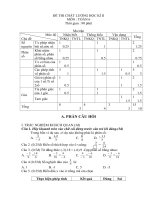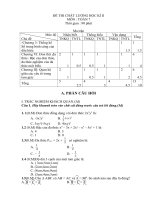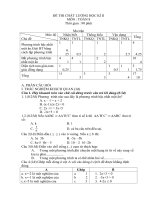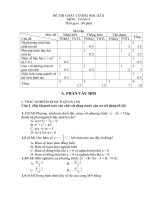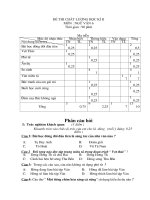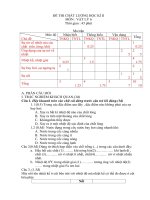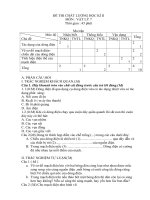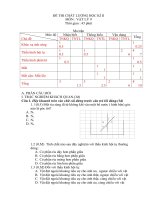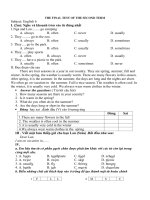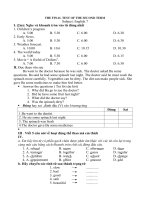150908-ma-tran-so-sanh-yeu-cau-iso-9001-2015-vs-iso-9001-2008
Bạn đang xem bản rút gọn của tài liệu. Xem và tải ngay bản đầy đủ của tài liệu tại đây (589.93 KB, 11 trang )
FDIS ISO 9001:2015 vs. ISO 9001:2008
FDIS ISO 9001:2015 vs.
ISO 9001:2008
Copyright ©2015 9001Academy. All rights reserved.
1
FDIS ISO 9001:2015 vs. ISO 9001:2008
FDIS ISO 9001:2015
ISO 9001:2008
Introduction
Introduction
0.1 General
0.1 General
0.2 Quality management
principles
Explanation
These clauses are almost the same; the new version explains the context of
the organization and its influence on the structure of the quality
management system (QMS), while pointing out that the standard does not
imply a need for uniformity in the structure of the QMS. Additionally,
enhancing customer satisfaction is pointed out in this clause.
The 2008 revision of the standard only mentions that the quality
management principles are taken into consideration; the 2015 revision lists
the quality management principles, pointing out that detailed descriptions
of the principles are given in ISO 9000.
0.3 Process approach
0.2 Process approach
The clause name is the same, but the 2015 revision has three sections that
explain the process approach, PDCA cycle, and risk-based thinking. For
more information, read Plan-Do-Check-Act in the ISO 9001 Standard.
0.4 Relationships with other
management system standards
0.4 Compatibility with other
management systems
This clause of the new version of the standard refers to ISO 9000, ISO 9004,
and Annex B of the standard, which provides more details of other
standards on quality management.
Quality Management Systems –
Requirements
Quality Management Systems –
Requirements
1 Scope
1 Scope
2 Normative references
2 Normative references
3 Terms and definitions
3 Terms and definitions
Copyright ©2015 9001Academy. All rights reserved.
These clauses are almost the same for both versions of the standard.
The new version refers to ISO 9000:2015.
2
FDIS ISO 9001:2015 vs. ISO 9001:2008
FDIS ISO 9001:2015
ISO 9001:2008
Explanation
4 Context of the organization
4.1 Understanding organization
and its context
This is a completely new requirement; the organization will need to
determine the external and internal context that affects the organization.
For more information, read How to identify the context of the organization
in ISO 9001:2015.
4.2 Understanding needs and
expectations of interested parties
Interested parties are introduced in the new version of the standard. The
previous version was only focused on the customer.
4.3 Determining the scope of the
quality management system
4.2.2 Quality manual
This requirement was related to the Quality Manual in the previous version.
The Quality Manual is not mandatory anymore, but the requirement for
determining and documenting the scope remains. For more information,
read What clauses can be excluded in ISO 9001:2015? and The future of the
Quality Manual in ISO 9001:2015.
4.4 Quality management system
and its processes
4.1 General requirements
The requirements from the previous version remain; the new requirements
are related to determining the risks and opportunities and inputs and
outputs of the processes, as well as assigning responsibilities and authorities
for the processes.
5.1 Management commitment
The clauses are very similar; the emphasis in the new version is on
promoting awareness and support of other persons who contribute to the
effectiveness of the QMS. The main difference between the clauses is that
the new version requires the top management to take accountability for the
effectiveness of the QMS. For more information, read How to comply with
new leadership requirements in ISO 9001:2015.
5 Leadership
5.1 Leadership and commitment
5.1.1 Leadership and commitment
for the quality management
system
5.4.2 Quality management system
Planning
Copyright ©2015 9001Academy. All rights reserved.
3
FDIS ISO 9001:2015 vs. ISO 9001:2008
FDIS ISO 9001:2015
ISO 9001:2008
Explanation
5.1.2 Customer focus
5.2 Customer focus
The old requirements remain the same. Determination of the risks and
opportunities regarding conformity of products and services is a new
requirement, as well as the consideration of the statutory and regulatory
requirements.
5.2 Quality policy
5.3 Quality Policy
The requirements remain the same. An additional requirement is to be
available to interested parties, as appropriate. See the sample document
here: Quality Policy. For more information, read How to Write a Good
Quality Policy.
5.3 Organizational roles,
responsibilities and authorities
5.5.1 Responsibility and authority
The main difference is that the new standard does not require appointing a
management representative; however, the new clause describes in more
detail the roles, responsibilities and authorities within the QMS, implying
that they can be allocated to different persons.
6 Planning for the quality
management system
6.1 Actions to address risks and
opportunities
This is a completely new requirement. When planning the QMS, the
organization will need to determine the risks and opportunities affecting the
organization. For more information, read this article: The Role of Risk
Assessment in the QMS.
6.2 Quality objectives and
planning to achieve them
5.4.1 Quality objectives
The requirements remain the same, but are further elaborated in the new
version. See the sample document here: Quality Objectives. For more
information, read How to Write Good Quality Objectives.
6.3 Planning of changes
5.4.2 Quality management system
planning
The new version of the standard defines how the changes in the QMS should
be managed by considering the purpose of the change, the potential
consequences, and availability of resources and allocation of responsibilities.
Copyright ©2015 9001Academy. All rights reserved.
4
FDIS ISO 9001:2015 vs. ISO 9001:2008
FDIS ISO 9001:2015
ISO 9001:2008
Explanation
6.1 Provision of resources
The old requirements remain, but new version emphasizes consideration of
capabilities and constraints of the organization, as well as resources
obtained from external providers.
7.1.2 People
6.2.1 General
The requirements of both clauses are pretty much the same.
7.1.3 Infrastructure
6.3 Infrastructure
The requirements of both clauses are pretty much the same.
7.1.4 Environment for the
operation of process
6.4 Working environment
The requirements of both clauses are pretty much the same.
7.1.5 Monitoring and measuring
resources
7.6 Control of monitoring and
measuring equipment
The new version of the standard emphasizes the provision of resources for
monitoring and measurement. The organization must retain the
documented information as evidence of fitness for purpose of monitoring
and measurement resources. The old standard only focuses on the
measuring equipment. See the sample document here: Maintenance and
Calibration Record.
7 Support
7.1 Resources
7.1.1 General
7.1.6 Organizational knowledge
7.2 Competence
This is a completely new requirement, which acknowledges the
organizational knowledge as an important resource. The organization will
need to determine the knowledge necessary to run its processes and achieve
conformity of products and services.
6.2.2 Competence, training and
awareness
7.3 Awareness
Copyright ©2015 9001Academy. All rights reserved.
Competence and awareness are split into different clauses to emphasize
their importance and provide more detailed requirements. See the sample
document here: Procedure for Human Resources. For more information,
read Using Competence, Training and Awareness to Replace Documentation
in your QMS.
5
FDIS ISO 9001:2015 vs. ISO 9001:2008
FDIS ISO 9001:2015
ISO 9001:2008
Explanation
7.4 Communication
5.5.3 Internal communication
The new clause includes both external and internal communication and
requires definition of responsibility and methods of communication.
7.5 Documented information
4.2.3 Control of documents
Documents and records now belong to the same category – documented
information. The requirements of both versions are equivalent. See the
sample document here: Procedure for Document and Record Control. For
more information, read New approach to document and record control in
ISO 9001:2015.
7.5.1 General
4.2.4 Control of records
7.5.2 Creating and updating
7.5.3 Control of documented
information
8 Operation
7 Product realization
8.1 Operational planning and
control
7.1 Planning product realization
The requirements of both clauses are equivalent. See the sample document
here: Procedure for Production and Service Provision.
8.2 Requirements for products
and services
7.2 Customer-related processes
The requirements are almost the same, but the new version emphasizes
communication about treatment of customer property. See the sample
document here: Notification to a Customer about Changes on his Property.
8.2.1 Customer communication
7.2.3 Customer communication
8.2.2 Determining the
requirements related to products
and services
7.2.1 Determination of requirements
related to the product
The requirements of both clauses are pretty much the same. See the sample
document here: Sales Procedure.
8.2.3 Review of requirements
related to products and services
7.2.2 Review of requirements related
to the product
The requirements of both clauses are pretty much the same. See the sample
document here: Customer Requirement Review Checklist.
8.2.4 Changes to requirement for
product and services
Copyright ©2015 9001Academy. All rights reserved.
This new clause defines requirements related to changes in requirements
related to products and services.
6
FDIS ISO 9001:2015 vs. ISO 9001:2008
FDIS ISO 9001:2015
ISO 9001:2008
Explanation
8.3 Design and development of
products and services
7.3 Design and development
The requirements of both clauses are pretty much the same. See the sample
document here: Procedure for Design and Development.
8.3.1 General
This clause defines when the design and development process is necessary.
8.3.2 Design and development
planning
7.3.1 Design and development
planning
The requirements of both clauses are pretty much the same. See the sample
document here: Procedure for Design and Development.
8.3.3 Design and development
inputs
7.3.2 Design and development inputs
The requirements of both clauses are pretty much the same. See the sample
document here: Project Task.
8.3.4 Design and development
controls
7.3.4 Design and development review
The new clause sublimates the requirements of the three old clauses,
keeping the old requirements and emphasizing the consideration of nature,
duration, and complexity of design and development activities. See the
sample document here: Project Plan and Review. For more information read
ISO9001 Design Verification vs Design Validation.
7.3.5 Design and development
verification
7.3.6 Design and development
validation
8.3.5 Design and development
outputs
7.3.3 Design and development
outputs
The requirements of both clauses are pretty much the same. See the sample
document here: Design Review Minutes.
8.3.6 Design and development
changes
7.3.7 Control of design and
development changes
The requirements of both clauses are pretty much the same. See the sample
document here: Change Review Record.
8.4 Control of externally provided
products and services
7.4.1 Purchasing process
Although the name of the clause has changed, the requirements are pretty
much the same. See the sample document here: Procedure for Purchasing
and Evaluation of Suppliers.
7.4.3 Verification of purchased
product
The requirements of both clauses are pretty much the same. See the sample
document here: Procedure for Purchasing and Evaluation of Suppliers. For
8.4.1 General
8.4.2 Type and extent of control
of external provision
Copyright ©2015 9001Academy. All rights reserved.
7
FDIS ISO 9001:2015 vs. ISO 9001:2008
FDIS ISO 9001:2015
ISO 9001:2008
Explanation
more information, read How to control outsourced processes using ISO
9001.
8.4.3 Information for external
providers
7.4.2 Purchasing information
The requirements of both clauses are pretty much the same. The new
version emphasizes the monitoring and control of external providers’
performance.
8.5 Production and service
provision
7.5 Production and service provision
8.5.1 Control of production and
service provision
7.5.1 Control of production and
service provision
The requirements are almost the same, but the new standard points out that
the implemented controlled conditions are for delivery and post-delivery
activities. See the sample document here: Procedure for Production and
Service Provision. For more information, read Understanding Product &
Service Provision in ISO 9001.
7.5.2 Validation of processes for
production and service provision
8.5.2 Identification and
traceability
7.5.3 Identification and traceability
The requirements of both clauses are pretty much the same. See the sample
document here: Record of Traceability.
8.5.3 Property belonging to
customers or external providers
7.5.4 Customer property
The requirements of both clauses are the same, but in the new standard the
requirements are extended to property belonging to external providers as
well. See the sample document here: Notification to a Customer about
Changes on his Property.
8.5.4 Preservation
7.5.5 Preservation of product
The requirements of both clauses are the same.
8.5.5 Post-delivery activities
The post-delivery activities are mentioned in several places in the old
version, but in the new standards they are set apart as a separate sub clause.
8.5.6 Control of changes
The control of changes is mentioned in several places in the old version;
however, the importance of controlling changes is stressed in the new
standard by defining a separate sub clause.
Copyright ©2015 9001Academy. All rights reserved.
8
FDIS ISO 9001:2015 vs. ISO 9001:2008
FDIS ISO 9001:2015
ISO 9001:2008
8.6 Release of products and
services
8.7 Control of nonconforming
outputs
Explanation
This is a new requirement, dealing with verification of product and ensuring
that product or service meets requirements.
8.3 Control of nonconforming
product
The requirements are equivalent. See the sample document here: Procedure
for Control of Nonconforming Product.
9.1 Monitoring, measurement,
analysis and evaluation
8.2.3 Monitoring and measurement
of processes
The new clause sublimates all requirements for processes and products or
services monitoring and measurement.
9.1.1 General
8.2.4 Monitoring and measurement
of product
9.1.2 Customer satisfaction
8.2.1 Customer satisfaction
The requirements are the same. See the sample document here: Procedure
for Measuring Customer Satisfaction.
9.1.3 Analysis and evaluation
8.4 Analysis of data
The requirements are equivalent. See the sample document here: Data
Analysis Report.
9.2 Internal audit
8.2.2 Internal audit
The requirements are equivalent. The main difference is that the new
standard does not require a documented procedure. See the sample
document here: Procedure for Internal Audit. For more information, read
Five Main Steps in ISO 9001 Internal Audit.
9.3 Management review
5.6 Management review
The requirements are equivalent. See the sample document here: Procedure
for Management Review. For more information, read How to Make
Management Review More Practical.
9 Performance evaluation
Copyright ©2015 9001Academy. All rights reserved.
9
FDIS ISO 9001:2015 vs. ISO 9001:2008
FDIS ISO 9001:2015
ISO 9001:2008
10 Improvement
8.5 Improvement
10.1 General
Explanation
The requirements in the new standard explain what should be considered in
the process of improvement.
10.2 Nonconformity and
corrective action
8.5.2 Corrective action
The requirements are equivalent. See the sample document here: Procedure
for Corrective and Preventive Action. For more information, read
Understanding dispositions for ISO 9001 nonconforming product.
10.3 Continual improvement
8.5.1 Continual improvement
The new standard points out the need to use all available information for
continually improving the QMS. For more information, read Seven Steps for
Corrective and Preventive Actions to support Continual Improvement.
Annex A – Clarification of new
structure, terminology and
concepts
Annex A explains the new structure of the 2015 revision together with key
new terms and concepts.
Annex B - Other International
Standards on quality
management and quality
management systems developed
by ISO/TC 176
Annex B lists all ISO standards related to ISO 9001 and clauses to which
each of the listed standards is referring.
Copyright ©2015 9001Academy. All rights reserved.
10
EPPS Services Ltd.
for electronic business and business consulting
UI. Vladimira Nazora 59, 10000 Zagreb
Croatia, European Union
1
Email:
Phone: +1 (646) 759 9933
Toll-Free (U.S. and Canada): 1-888-553-2256
Toll-Free (United Kingdom): 0800 808 5485
Fax: +385 1 556 0711
Copyright ©2014 9001Academy. All rights reserved.
